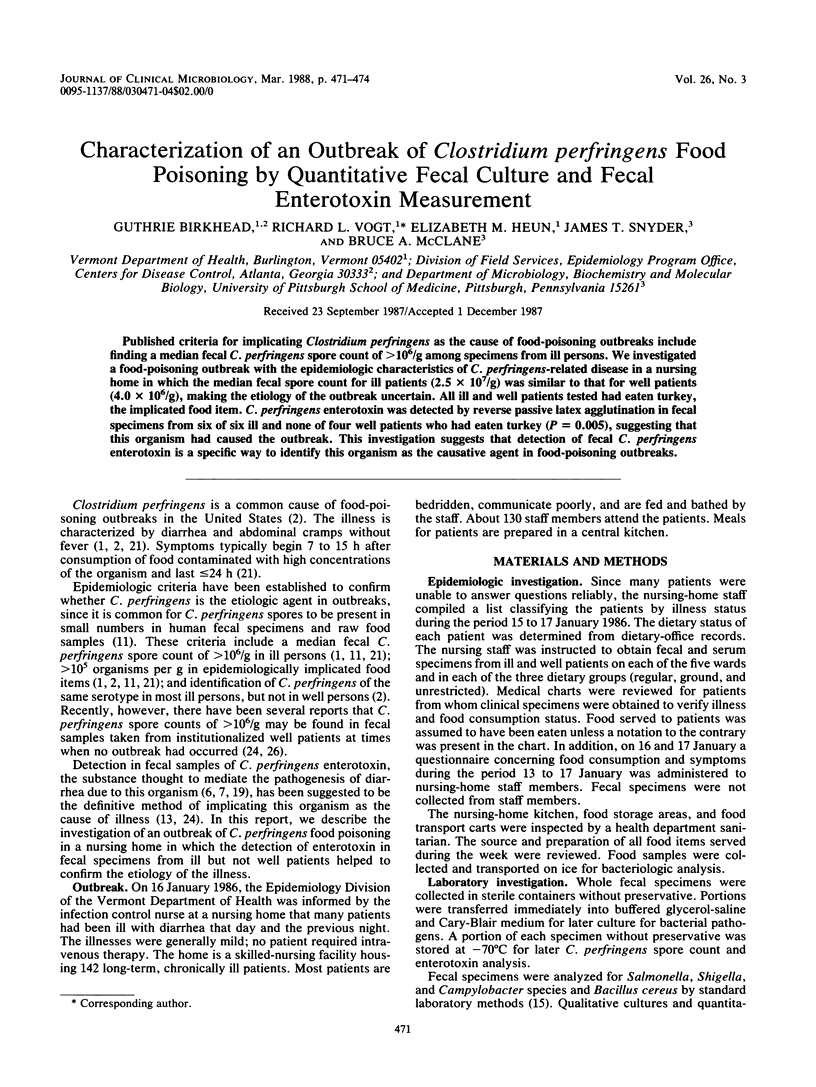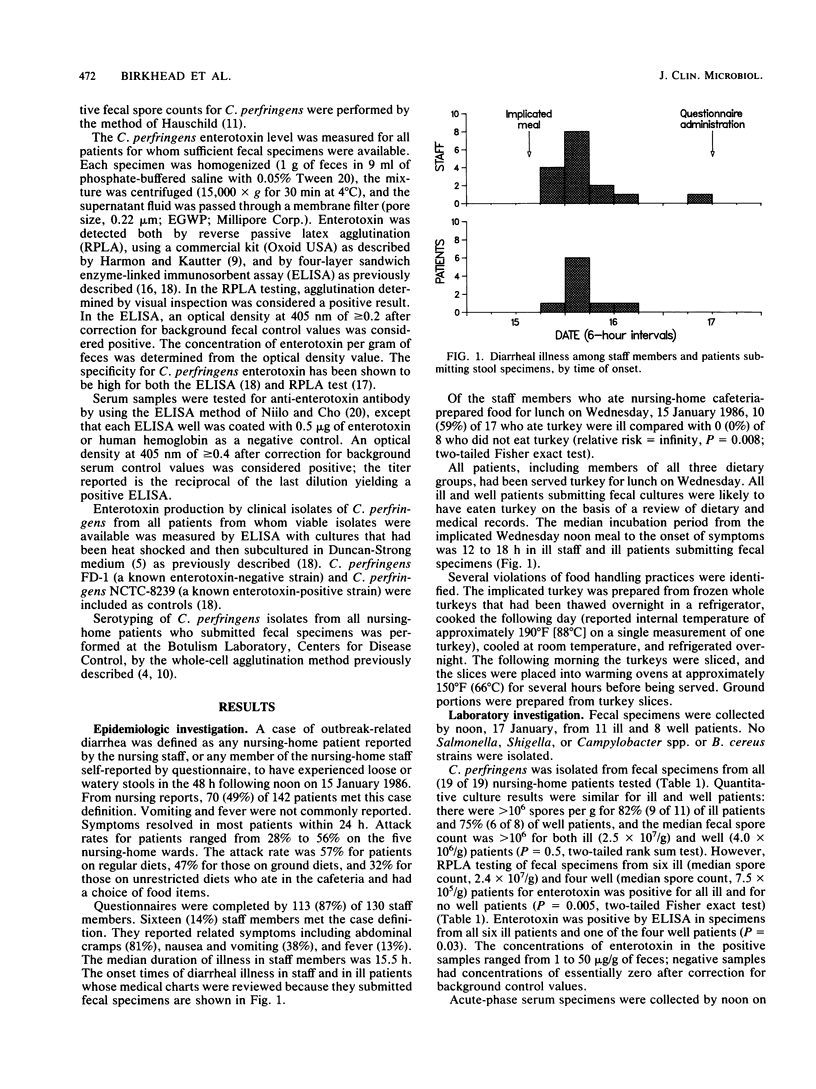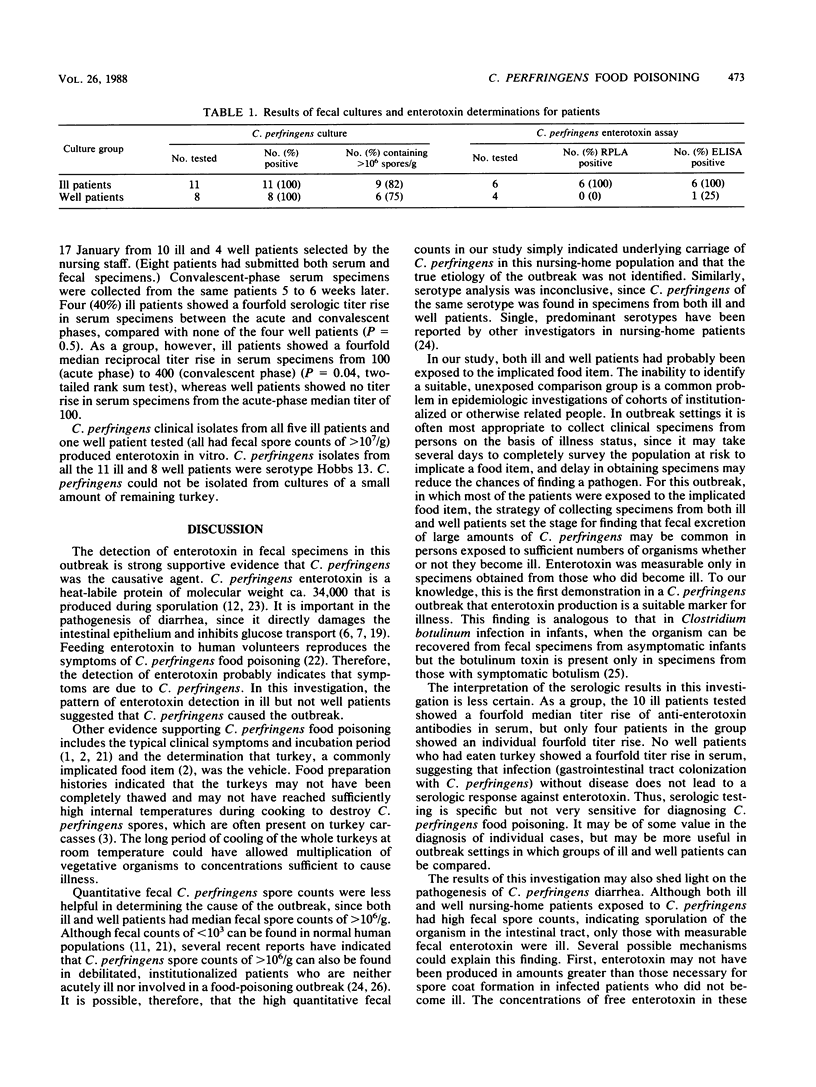Abstract
Published criteria for implicating Clostridium perfringens as the cause of food-poisoning outbreaks include finding a median fecal C. perfringens spore count of greater than 10(6)/g among specimens from ill persons. We investigated a food-poisoning outbreak with the epidemiologic characteristics of C. perfringens-related disease in a nursing home in which the median fecal spore count for ill patients (2.5 X 10(7)/g) was similar to that for well patients (4.0 X 10(6)/g), making the etiology of the outbreak uncertain. All ill and well patients tested had eaten turkey, the implicated food item. C. perfringens enterotoxin was detected by reverse passive latex agglutination in fecal specimens from six of six ill and none of four well patients who had eaten turkey (P = 0.005), suggesting that this organism had caused the outbreak. This investigation suggests that detection of fecal C. perfringens enterotoxin is a specific way to identify this organism as the causative agent in food-poisoning outbreaks.
Full text
PDF



Selected References
These references are in PubMed. This may not be the complete list of references from this article.
- Duncan C. L., Strong D. H. Clostridium perfringens Type A Food Poisoning I. Response of the Rabbit Ileum as an Indication of Enteropathogenicity of Strains of Clostridium perfringens in Monkeys. Infect Immun. 1971 Jan;3(1):167–170. doi: 10.1128/iai.3.1.167-170.1971. [DOI] [PMC free article] [PubMed] [Google Scholar]
- Duncan C. L., Strong D. H. Ileal loop fluid accumulation and production of diarrhea in rabbits by cell-free products of Clostridium perfringens. J Bacteriol. 1969 Oct;100(1):86–94. doi: 10.1128/jb.100.1.86-94.1969. [DOI] [PMC free article] [PubMed] [Google Scholar]
- Duncan C. L., Strong D. H. Improved medium for sporulation of Clostridium perfringens. Appl Microbiol. 1968 Jan;16(1):82–89. doi: 10.1128/am.16.1.82-89.1968. [DOI] [PMC free article] [PubMed] [Google Scholar]
- Goldner S. B., Solberg M., Jones S., Post L. S. Enterotoxin synthesis by nonsporulating cultures of Clostridium perfringens. Appl Environ Microbiol. 1986 Sep;52(3):407–412. doi: 10.1128/aem.52.3.407-412.1986. [DOI] [PMC free article] [PubMed] [Google Scholar]
- Hauschild A. H. Criteria and procedures for implicating Clostridium perfringens in food-borne outbreaks. Can J Public Health. 1975 Sep-Oct;66(5):388–392. [PubMed] [Google Scholar]
- Jackson S. G., Yip-Chuck D. A., Clark J. B., Brodsky M. H. Diagnostic importance of Clostridium perfringens enterotoxin analysis in recurring enteritis among elderly, chronic care psychiatric patients. J Clin Microbiol. 1986 Apr;23(4):748–751. doi: 10.1128/jcm.23.4.748-751.1986. [DOI] [PMC free article] [PubMed] [Google Scholar]
- McClane B. A., Snyder J. T. Development and preliminary evaluation of a slide latex agglutination assay for detection of Clostridium perfringens type A enterotoxin. J Immunol Methods. 1987 Jun 26;100(1-2):131–136. doi: 10.1016/0022-1759(87)90181-5. [DOI] [PubMed] [Google Scholar]
- McClane B. A., Strouse R. J. Rapid detection of Clostridium perfringens type A enterotoxin by enzyme-linked immunosorbent assay. J Clin Microbiol. 1984 Feb;19(2):112–115. doi: 10.1128/jcm.19.2.112-115.1984. [DOI] [PMC free article] [PubMed] [Google Scholar]
- Niilo L., Cho H. J. An enzyme-linked immunosorbent assay for the detection of Clostridium perfringens enterotoxin antibody. Can J Comp Med. 1984 Jan;48(1):111–112. [PMC free article] [PubMed] [Google Scholar]
- Shandera W. X., Tacket C. O., Blake P. A. Food poisoning due to Clostridium perfringens in the United States. J Infect Dis. 1983 Jan;147(1):167–170. doi: 10.1093/infdis/147.1.167. [DOI] [PubMed] [Google Scholar]
- Skjelkvåle R., Uemura T. Experimental Diarrhoea in human volunteers following oral administration of Clostridium perfringens enterotoxin. J Appl Bacteriol. 1977 Oct;43(2):281–286. doi: 10.1111/j.1365-2672.1977.tb00752.x. [DOI] [PubMed] [Google Scholar]
- Stringer M. F., Watson G. N., Gilbert R. J., Wallace J. G., Hassall J. E., Tanner E. I., Webber P. P. Faecal carriage of Clostridium perfringens. J Hyg (Lond) 1985 Oct;95(2):277–288. doi: 10.1017/s0022172400062707. [DOI] [PMC free article] [PubMed] [Google Scholar]
- Thompson J. A., Glasgow L. A., Warpinski J. R., Olson C. Infant botulism: clinical spectrum and epidemiology. Pediatrics. 1980 Dec;66(6):936–942. [PubMed] [Google Scholar]
- Yamagishi T., Serikawa T., Morita R., Nakamura S., Nishida S. Persistent high numbers of Clostridium perfringens in the intestines of Japanese aged adults. Jpn J Microbiol. 1976 Oct;20(5):397–403. doi: 10.1111/j.1348-0421.1976.tb01005.x. [DOI] [PubMed] [Google Scholar]


